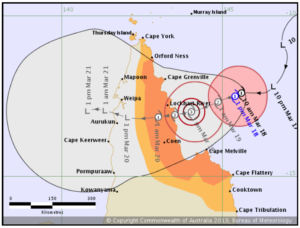
Photo: Bureau of Meteorology
Tropical Cyclone Trevor has formed in the early hours of this morning off Queensland’s Cape York Peninsula and is predicted to bring destructive winds and potentially flooding to the state’s far north.
The category one system is about 500 kilometres north of Cairns and moving west-southwest at 10 kilometres per hour towards the Cape York Peninsula coast.
Tropical Cyclone Trevor is expected to continue to intensify to category 3 system before crossing the eastern Cape York Peninsula coast on Tuesday evening.
Gale force winds are expected to develop between Orford Ness and Cape Flattery Monday evening and may extend north to the Torres Strait Islands or south to Cape Tribulation on Tuesday.
Heavy rain, which may lead to flash flooding, is forecast to develop across far north Queensland over the next few days while abnormally high tides are also expected in coastal areas.
People between Orford Ness and Cape Flattery, including Lockhart River and Coen, are advised to finalise their preparation for the cyclone impacts.
People elsewhere between the Torres Strait Islands and Cape Tribulation, including Cooktown should consider what action they will need to take if the cyclone threat increases.
- Check your emergency kit and make sure it’s stocked with essential items including food, water, dry clothes, medications, first aid supplies, important documents, valuables, a battery-powered or wind up radio and sleeping gear.
- Get your property ready by securing large outdoor items like swing sets and trampolines. Smaller items including outdoor tables and chairs, barbeques and toys should be brought inside if possible.
- If you live in areas likely to be impacted by flooding, elevate belongings.
- Tape the inside of your windows in a criss-cross fashion using strong packing tape.
- Withdraw enough cash to cover essential items such as food, water or petrol.
- Ensure you have enough water stored in bottles, buckets or your bath in case water becomes restricted.
- Charge your mobile phones.
- Discuss your emergency plans with your family and friends. Identify a safe place to shelter when the cyclone hits and know where you will go and what you will take if you need to evacuate.
- Consider what you will do to keep your pets safe. Find a place they can shelter and have food and water available.
For further cyclone preparedness and safety advice, visit Queensland’s Disaster Management Services website (www.disaster.qld.gov.au) and for emergency assistance call the Queensland State Emergency Service (SES) on 132 500.














